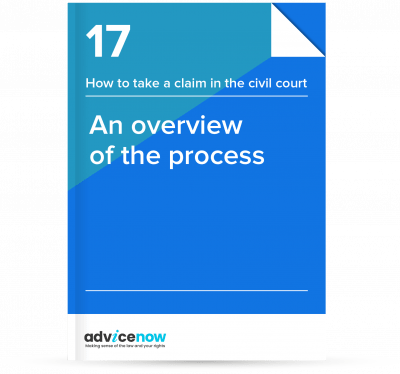1.Ceri fills in a paper N1 claim form including the section called the particulars of claim. (It is also possible to use an online process to start a claim). See How to start a civil claim for more details.
| Claim form - the form that starts a case and where the Claimant explains what they are asking for.
Particulars of claim - a concise written statement of the facts and law on which your claim is based and what you want from the defendant. This statement must show that you have a cause of action – a legal right to bring a claim against the defendant. (This is called claim details in the online service for small claims).
|
| 2. Ceri photocopies the completed claim form and Particulars of Claim. Ceri needs one for the court, one for Rory and one to keep. | |
3. Ceri sends the original claim form plus two copies to the court together with the correct fee. If eligible, she can ask for help to pay the court fee by completing Form EX160 and including that with her claim instead. (Everyone is sent a copy automatically on the online system. She can also make an application for help with court fees online if she thinks she is eligible. If you use the online system to make a claim, you must use the online process to apply for help with fees too) | |
4. The court sends Rory a copy of Ceri’s claim form and a response pack by first class post. The response pack includes the forms Rory needs to reply to Ceri’s claim. (If you make a small claim online, the Defendant is emailed a copy of the claim form -if the Defendant's email address was supplied - and can respond online. If they don't respond online, the case moves to paper and continues as below) | Response pack - the pack of forms and information sent to a Defendant after a claim starts. |
5. The court sends Ceri a notice of issue. This confirms that Ceri’s case has started and includes the date of service. (This all happens automatically if you use the small claims online service). | Notice of issue - this tells you that your claim has started, the date it began, the case number, date and method of service and the deadline by when the defendant has to respond.
Service - formal delivery of court documents.
|
6. Rory has 14 days from the date of service to decide what to do next and to reply. (If using the small claims online service and Rory’s email address was supplied, Rory has 19 days to respond from the day the claim was submitted). | |
7. Rory does not agree with Ceri’s claim. Rory fills in the defence form in the response pack and returns it to the court. If he had needed more time he could have completed the acknowledgement of service form and returned that to the court within the initial 14 days. He would then have had a further 14 days to complete and send in the defence form. (If using the small claims online service Rory responds online. He also has an option of an extra 14 days). | Acknowledgement of service form – the form the defendant can complete to confirm they have received the claim documents and to give themselves a little more time to respond.
Defence form - the form the Defendant completes to explain why they dispute the claim.
|
8. The court sends Ceri and Rory a copy of the defence form, a notice of proposed allocation and a directions questionnaire. (If using the small claims online service Ceri views Rory’s response online and decides whether to continue with the case or accept his offer - if he made one. It has already been decided that the case will be dealt with as a small claim.) | Notice of proposed allocation - this tells you which route (‘track’) the court thinks your case should take through the court system. This might be the small claims track, fast track or for more complicated claims the intermediate or multi-track. This guide explains the process in small claims or fast track only.
Directions questionnaire - a questionnaire that helps the court decide how to deal with your case and which track to allocate your case to. There are separate questionnaries for the small claims track and the fast, intermediate, or multi-track.
|
9. Ceri and Rory discuss whether they can agree any of the answers to the directions questionnaire. They decide they can agree how long the trial will last. |
Trial - the final hearing when the judge decides who wins and who loses the case. |
10. Ceri and Rory both fill in a directions questionnaire and return it to the court by the date stated on the notice of proposed allocation. They also send a copy to each other. | |
| 11. A judge looks at the information in the directions questionnaires and decides how the case will progress from now on. | |
12. The court sends Ceri and Rory a notice of allocation. This allocates (or assigns) the case to the fast track. The notice (a type of court order) also tells Ceri and Rory what to do next. These instructions are called directions. If the case had been allocated to the small claims track, Ceri and Rory would now be offered free mediation. All small claims (including those made online) except those involving the Child Support Agency, HMRC, personal injury over £5,000, and road traffic accidents involving personal injury are offered free mediation. They would be given a two-hour window in which the mediator speaks to both separately by telephone to see if a way forward can be agreed. If the mediation is not successful it has no impact on the final decision, and does not delay the case. They can currently opt-out of mediation, but the Government has announced plans for mediation to be compulsory. See After you start a civil claimfor more details.
| Notice of allocation - this tells you which track your case has been allocated to, small claims, fast, intermediate or multi track.
Directions – instructions from the court for how a case will be dealt with. These must be complied with. |
13. Ceri and Rory both fill in a form called a list of documents and send the other a copy. They do this by the date given in the judge’s instructions which will be about 4 weeks after allocation. This step is called disclosure. If you are using the online service all of this has already happened. You provided a list of documents and a timeline when you started or responded to the case. Next you provide details of your requirements for a court hearing. Once that is done there is nothing more to do until the trial (unless you have asked for and been given permission to use an expert). | List of documents - the form you use to list the documents and any other evidence that is relevant to your case.
Allocation - the process of deciding which track the case should follow.
Disclosure - the process of telling the other side what evidence you have.
Inspection is showing the evidence that supports your case to the other party. See After you start a civil claim
for more details and guidance on what to do. |
| 14. Ceri asks for copies of some of the documents listed on Rory’s list of documents, and Rory provides them. | |
| 15. Rory asks for copies of some of the documents listed on Ceri’s list of documents, and Ceri provides them. | |
16. Ceri and Rory exchange witness statements. They do this by the date given in the judge’s directions which will be about 10 weeks after allocation. See Witness statements and expert reports for guidance on what to put in them and how to lay them out.
| Witness statement - a document in which someone explains what they saw, did or heard. |
17. Ceri and Rory exchange expert reports (if any). They do this by the date given in the judge’s directions which will be about 14 weeks after allocation. See Witness statements and expert reports for more help.
|
|
18. Ceri and Rory’s experts (if any) speak to each other to work out where they agree with each other and to try and reduce the number of things they disagree about. |
|
| 19. The court sends Ceri and Rory a pre-trial checklist. This happens about 20 weeks after allocation. The court also tells them the date by which the checklists must be returned. | Pre-trial checklist - the form you use to tell the court how your case is progressing in the run up to the trial.
|
| 20. Ceri and Rory discuss whether they can agree what information should go in the pre-trial checklist. | |
| 21. Ceri and Rory both fill in a pre-trial checklist (also called a listing questionnaire) and return it to the court by the date stated on the front of the form. | Listing questionnaire – another name for the pre-trial checklist. |
22. The court sends further directions and tells Ceri to give the court and Rory trial bundle 7 days before the trial. See How to prepare a trial bundle and index for more information.
| Trial bundle - a pack combining both sides' documents with a list at the front showing what’s in it. |
| 23. The court sends Ceri and Rory a notice of trial date and tells Ceri what hearing fee she must pay and the date by which she must pay it. (If eligible, she can ask for help to pay the court fee by completing Form EX160.) Ceri and Rory have about 3 weeks to get ready for the trial. The trial takes place about 30 weeks after allocation. | Notice of trial date – this tells you when and where your trial will take place, how much the trial fee is, and the deadline for paying it. |
24. The trial takes place and the judge makes a decision after hearing the evidence. SeeEvidence needed to sue someone. See also Hearings in a civil claim for more details. | Evidence - information or materials relevant to proving the facts of your case. This may include information that doesn’t support your case – information that may end up helping the other side.
|
| 25. The court sends both Ceri and Rory a copy of the court order containing the judgment. | Court order - the judge’s written decision. |

